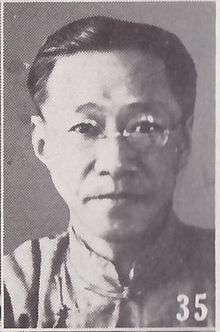Weng Wenhao
| Weng Wenhao | |
|---|---|
| 翁文灝 | |
 | |
| Premier of the Republic of China | |
|
In office 24 May 1948 – 26 November 1948 | |
| President | Chiang Kai-shek |
| Personal details | |
| Born |
26 July 1889 Ningbo, Zhejiang, Qing Dynasty |
| Died |
27 January 1971 (aged 81) Beijing, China |
| Nationality | Republic of China |
| Political party | Kuomintang |
| Alma mater | Catholic University of Leuven |
Weng Wenhao (simplified Chinese: 翁文灏; traditional Chinese: 翁文灝; pinyin: Wēng Wénhào; 26 July 1889 – 27 January 1971) was a Chinese geologist, educator, and paramount politician.
He was one of the earliest modern Chinese geologists, and is regarded as the founder of modern Chinese geology and the father of modern Chinese oil industry in much literature.
From May to November 1948, Weng served as the President of the Executive Yuan of the Republic of China. The position is most commonly referred to as prime minister or premier.
Life
Early years
He was born in 1889 in Cixi, Ningbo, Zhejiang Province in late Qing Dynasty, and his courtesy name was Yongni (咏霓). His father was a locally famous businessman.
In 1902, he was only a 13-year-old boy but won the title of "skillful writer" (秀才) in the Imperial Examination. Later, he went to Shanghai and then entered a French-speaking Catholic school there.
He obtained his doctor's degree on geology from the Catholic University of Leuven, Flanders, Belgium, in 1912. He was the first Chinese person to hold a western doctor's degree in geology.
ROC period
In 1912, after obtaining his doctor's degree in geology, he went back to China. He served as the Minister of Mine Industry and the Minister of Agriculture and Commerce, Beiyang Government. At the same time, he was also a lecturer and the chief professor (director, from 1914) of the National Research Institute of Geography. Together with Ding Wenjiang, he founded the new National Geological Survey.[1]
He was also a professor of geology in both Beijing University and Tsinghua University. He once was the head of the Department of Geography, Tsinghua University. In July 1931, he started serving as the acting president of Tsinghua University.
In 1928, he assisted Canadian paleoanthropologist Davidson Black in the establishment of the Cenozoic Research Laboratory for the research and appraisal of Peking Man fossils unearthed at Zhoukoudian.
During the period of Central (Provisional) Military Government of the Republic of China, he served in the central government as the General Secretary of the Executive Yuan (13 December 1935 – 9 September 1937); the Minister of Industry (till 1 January 1938), Minister of Education (28 October 1932 – 21 April 1933), and the Minister of Economy (1 January 1938 – 1947).
Invited by Chiang Kai-shek, He served as the first President of the Executive Yuan of Nationalist Government (capital Nanjing) (25 May 1948 – 26 November 1948).
In March 1948, he was selected to be a member of the Academia Sinica. After the establishment of the PRC, he also became a member of the Chinese Academy of Sciences. The Academia Sinica moved to Taipei in 1950, with most members moving to Taiwan or the United States thereafter.
After 1949 & Late years
After the Chinese Civil War, he relocated to Beijing and served in People's Political Consultative Conference with his longtime associate Qian Changzhao.
During the Cultural Revolution, he was specially protected by Zhou Enlai. In 1971, he died in Beijing.
Academic achievements & activities
- One of the founders of modern Chinese geography;
- Set up modern Chinese oil industry;
- Studies of the Peking Man;
- Studies of earthquake in China.
Family
He had four sons, the eldest one named Weng Xinyuan (翁心源), was a famous petroleum engineer who was killed in Cultural Revolution, the second oldest one named Weng Xinhan(翁心翰) was a pilot who was killed in the Second Sino-Japanese War.
The founder of Chinese modern geophysics - Weng Wenbo (翁文波), an academician of the Chinese Academy of Sciences, is his cousin.
Weng Xinzhi (翁心植), academician of Chinese Academy of Engineering, is his nephew.
Major works
- Studies of Earthquakes in Gansu Procince (《甘肃地震考》)
- A Brief Record of Minerals in China (《中国矿产志略》)
- Literary Collection of Zhuizhi (《椎指集》)
- Mourn for Mr. Ding Zai-Jun (《追悼丁在君先生》)
- Earthquake (《地震》)
- Quadrumana Fossils in China (《中国灵长类动物化石》)
- The First Record on Chinese Mine Industry (《第一次中国矿业纪要》)
- Paleozoic Plant Fossils in the Middle Part of Shanxi Province (《山西中部古生代植物化石》)
- An Elementary Introduction to Earthquake (《地震浅说》)
- Lectures on Geology (《地质学讲义》)
Further reading
| Wikimedia Commons has media related to Weng Wenhao. |
- Chronicle of Weng Wenhao, (《翁文灏年谱》), Oct. 2005
- Weng Wenhao's Outstanding Contributions to Chinese Oil Industry, (《翁文灏的石油业绩》)
- Selected Works of Weng Wenhao (《翁文灏选集》)
- Fiskesjö, Magnus and Chen Xingcan. _China Before China: Johan Gunnar Andersson, Ding Wenjiang, and the Discovery of China’s Prehistory / 中国之前的中国:安特生,丁文江,和中国史前史的发现_. Bilingual edition, in English and Chinese. Stockholm: MFEA monographs no. 15, 2004. ISBN 91-970616-3-8.
- Fiskesjö, Magnus. "Science across borders: Johan Gunnar Andersson and Ding Wenjiang." In: Stevan Harrell, Charles McKhann, Margaret Swain and Denise M. Glover, eds., _Explorers and Scientists in China's Borderlands, 1880-1950_. Seattle: University of Washington Press, 2011, pp. 240–66. ISBN 9780295991177.
- Shen, Grace Yen. _Unearthing the Nation: Modern Geology and Nationalism in Republican China._ Chicago: University of Chicago Press, 2014.
| Political offices | ||
|---|---|---|
| Preceded by Chang Chun |
Premier of the Republic of China 1948 |
Succeeded by Sun Fo |
References
- ↑ Shen, 2014; Fiskesjö, 2011; Fiskesjö and Chen 2004
